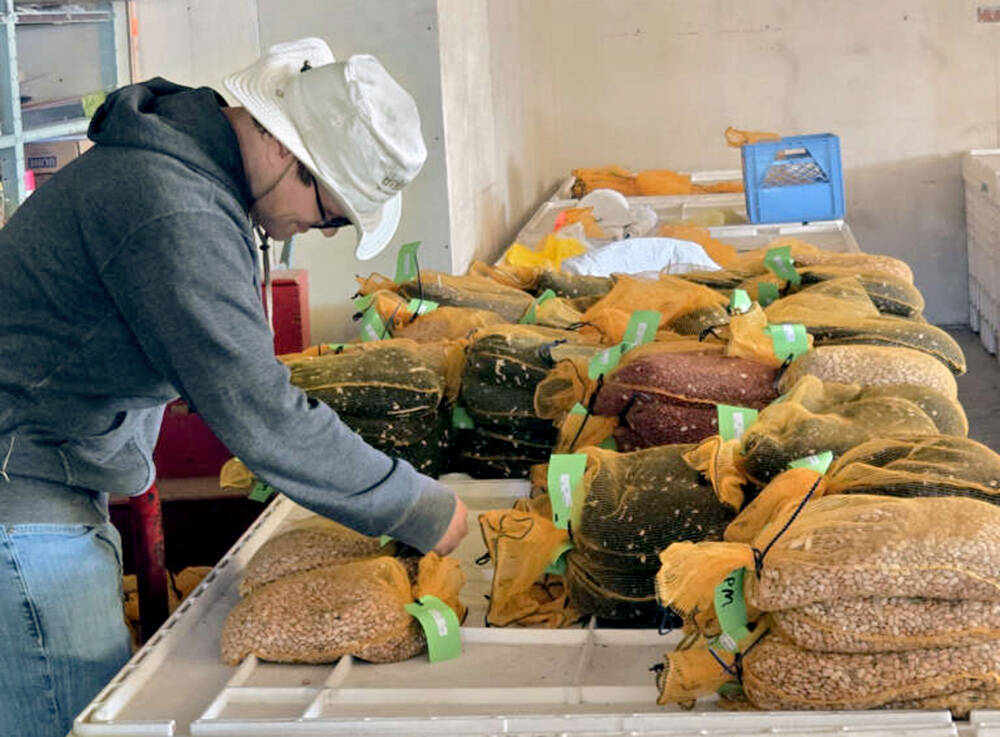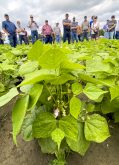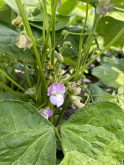The nematode’s resilience and prevalence in all of Ontario’s major soybean-producing areas makes managing the pest a challenge, though not impossible.
Farmers growing edible beans under processing contracts can keep soybean cyst nematodes (SCN) under control through strict rotation schedules of crops that don’t include SCN-susceptible soybean varieties, as well as crop scouting and soil testing.
Why it matters: Soybean cyst nematodes can hurt edible beans as well as soybeans, and once in the soil, the worms never go away. However, producers can keep nematodes at manageable levels by scouting, maintaining strict rotation schedules, and using SCN-resistant soybean cultivars in that rotation.
Read Also

Bean research breeds community giving
University of Guelph dry bean researcher Dr. Mohsen Yoosefzadeh Najafabadi champions sustainability by donating surplus breeding program beans to support food security and community art initiatives.
Chris Gillard, associate professor of dry bean agronomy and pests at the University of Guelph’s Ridgetown Campus said SCN has been around for some time.
“SCN is the number one soybean pest worldwide… Dry beans have been documented as an alternative host to SCN since the 1980s, but there’s been very little research on why.”
Edible beans fall into two broad categories based on the area from which they originated: small-seed Mesoamerican beans such as pinto, navy, and black; and large-seeded Andean beans like kidney and cranberry.
According to Gillard’s research, as well as other work from Agriculture and Agri-Food Canada and North Dakota State University, large-seed Andean varieties are much more susceptible to SCN than small-seed beans, but why remains a mystery.
“We don’t understand why or to what extent they respond differently,” said Gillard.
“We believe black beans and navy beans are much more resilient, but there’s evidence that there are also differences in cultivars within the navy bean class. Adzuki beans are another exception as they are much more susceptible to SCN than any other dry bean market class.”
Limited information useful for rotation schedules
With six to eight common cultivars for each class of market bean, research into which ones fare better against SCN is ongoing. However, Gillard said current knowledge can offer farmers practical ways to deal with the pest.
Knowing that large-seed beans are much more susceptible to SCN means bean producers and processors can make strategic decisions about where crops could and should be grown.
Hensall Co-operative Inc. and its bean growers, for example, regularly work together using Gillard’s SCN data to determine which market classes are most susceptible. Contracts can then be adjusted to avoid planting extra-susceptible varieties in higher-risk areas.
Even if SCN is not prolific, Gillard stressed the importance of using SCN-resistant soybean cultivars in annual rotation schedules, as well as naturally immune corn and cereal crops. Preventing SCN from accessing susceptible host plants reduces the population for subsequent growing seasons.
“Once you have (SCN), it never goes away,” he said. “When you do grow a susceptible crop, make sure you monitor it. This is the perfect time to start scouting.”
Looking for SCN damage in edible beans
In an article written for the Ontario Ministry of Agriculture, Food and Rural Affairs’ Field Crop News website, Meghan Moran, canola and edible bean specialist with OMAFRA, said SCN often goes unnoticed because plants appear healthy. The only evidence of SCN comes at the end of the growing season in the form of yield losses.
SCN can also cause symptoms normally indicative of other issues, such as leaf discolouration and stunting. That is why farmers must check the plant roots.
“Producers should soil sample fields to determine their risk of yield loss. Soil samples taken for fertility can be split and submitted to labs for SCN assessment,” said Moran in the article.
“In August, carefully dig up plant roots and look for small, pearl-white or yellow cysts. The cysts will be smaller than nodules on the roots.”
Gillard added that SCN does not overwinter well in moisture-laden ground, meaning sandy soils pose greater proliferation risks than clay. Farmers working with sandy soils must be more vigilant.
“You can’t just do the same thing you always did. You have to work within boundaries,” said Gillard.
Soybean cyst nematode is a voracious soybean pest well understood by researchers, but why it’s so effective at attacking edible beans is much less known
Large-seed Andean varieties are much more susceptible to SCN than small-seed beans, but why remains a mystery
Understanding chemical controls
No edible bean varieties resistant to soybean cyst nematode are currently available to growers. However, Gillard said several chemical controls can help manage the problem.
“They are currently registered for soybeans in Canada and we’d like to see them registered for use in dry beans too.”
He and his colleagues have investigated the effectiveness of seed treatments like VOTiVO and ILeVO, both Bayer products, as well as Clariva, a Syngenta chemistry, in field and laboratory trials for the last five years. The research team has concluded a mixture of VOTiVO and ILeVO can reduce SCN by 50 per cent in kidney beans.
Gillard said the mixture had little effect on black beans because they are inherently more tolerant to begin with. These tests were carried out in controlled environments, so field studies are needed, he added. Research investigating what chemistries work best on different edible bean varieties, as well as efforts to better understand the behaviour of individual cultivars, is also ongoing.
“To start, growers need to understand their risk from SCN,” he said. “They need to sample their fields and determine their SCN population. Then we can work on managing this pest on their farm.”













